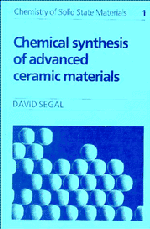Book contents
- Frontmatter
- Contents
- Preface
- Symbols
- 1 Introduction: the variety of ceramic systems
- 2 Conventional routes to ceramics
- 3 Ceramic fabrication
- 4 Sol–gel processing of colloids
- 5 Sol–gel processing of metal–organic compounds
- 6 Non-aqueous liquid-phase reactions
- 7 Polymer Pyrolysis
- 8 Hydrothermal synthesis of ceramic powders
- 9 Gas-phase reactions
- 10 Miscellaneous synthetic routes to ceramic materials
- Appendix: Determination of particle size
- References
- Index
2 - Conventional routes to ceramics
Published online by Cambridge University Press: 04 April 2011
- Frontmatter
- Contents
- Preface
- Symbols
- 1 Introduction: the variety of ceramic systems
- 2 Conventional routes to ceramics
- 3 Ceramic fabrication
- 4 Sol–gel processing of colloids
- 5 Sol–gel processing of metal–organic compounds
- 6 Non-aqueous liquid-phase reactions
- 7 Polymer Pyrolysis
- 8 Hydrothermal synthesis of ceramic powders
- 9 Gas-phase reactions
- 10 Miscellaneous synthetic routes to ceramic materials
- Appendix: Determination of particle size
- References
- Index
Summary
Introduction
Precipitation from solution, powder mixing and fusion are all conventional techniques for synthesis of traditional and advanced ceramics on both the laboratory and industrial scale. These methods, with selected examples, are described in this chapter together with limitations of their use for advanced ceramic materials. There is increasing demand for alternative routes to ceramic materials that impart superior properties compared with those attainable from conventional syntheses and the reasons for this continuing search for other synthetic pathways are also described here.
Precipitation from solution
Alumina occurs as the mineral bauxite and is refined in the Bayer process whereby ore is initially dissolved under pressure in sodium hydroxide so that solid impurities (SiO2, TiO2, Fe2O3) separate from sodium aluminate solution (Evans & Brown, 1981). This solution is either seeded with gibbsite crystals (α-Al2O3.3H2O) or undergoes auto- precipitation to bayerite (β-Al2O3.3H2O) after its neutralisation with CO2 gas. Temperature, alumina supersaturation and amount of seed affect particle size during crystallisation but, as for other precipitation reactions, the product is agglomerated (section 9.3). Alumina production from the Bayer process was 31.9 × 106 Mg in 1985; 90 weight % of this was reduced to metal and only 5 weight % found ceramic and refractory applications (MacZura, Carbone & Hart, 1987).
- Type
- Chapter
- Information
- Chemical Synthesis of Advanced Ceramic Materials , pp. 17 - 22Publisher: Cambridge University PressPrint publication year: 1989

